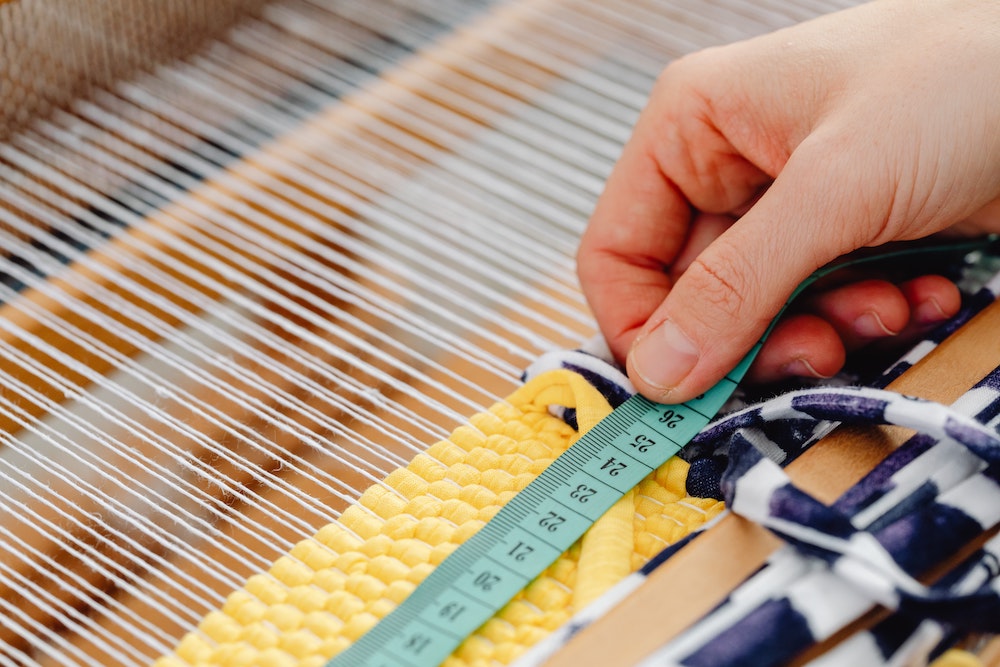Understanding the difference between positive ease and negative ease is essential for any fashion designer who wants to create well-fitting garments. When drafting patterns with a precise fit, not only is it important to pay attention to measurements but also the fabric properties of your final garment. By taking into account the stretch or non-stretch properties of a fabric and calculating the correct amount of positive or negative ease, you can avoid fit issues and draft a precise pattern. Measurements and fabric properties must be considered in tandem to avoid fit issues.
Since woven textiles are made from yarns that are woven together in a crisscross pattern that create little squares. The weave of a woven textile is not flexible and prevents the fabric from stretching. The fiber content, kind of weave and weight of a woven has an impact on how much the fabric will stretch. Cotton, linen, and wool all have minor stretch properties, whereas polyester does not stretch at all. However, with the addition of spandex fiber into a woven fabric, it is possible to create a woven that contains slightly more stretch than a typical woven fabric without spandex. Stretch wovens will have elasticity due to the actual fibers stretching rather than the woven criss cross pattern providing for elasticity, as would be the case with a knit stitch. But for brevity and scope, we will skip the discussion on stretch wovens in this post.
Due to the minimal to zero stretch of a woven fabric, slopers and patterns drafted for a woven fabric must incorporate positive ease. This means ease is added to the circumference measurements, resulting in a garment that is cut larger than the body measurements. Since woven fabrics have minimal to no stretch, when drafting slopers and patterns for a woven fabric, positive ease must be added to allow for comfort and movement. As such, you can apply a standard level of positive ease across different woven fabric types and you would not need to re-draft your slopers and patterns each time you change your fabric. The only time you would change the amount of positive ease added, would be to account for wearer comfort, the type of garment or to add design ease in order to create a tighter or looser fitting garment. For example, a close-fitting woven shirt might have 1” to 2” of positive ease added to the bust measurement while a loose-fitting blouse could have 3” to 4” of positive ease.
In contrast to drafting for wovens, slopers and patterns made for knit fabrics are drafted with negative ease. As mentioned earlier, this is because knit fabrics have stretch and will conform to fit the body when worn. When drafting patterns for a knit fabric, negative ease must be subtracted from the circumference measurements to account for the fact that the garment will conform to fit the body when worn. Thus, the final garment will be cut smaller than the body measurements.
The interlocking loops of a knit fabric is what gives the fabric its inherent stretch. As the fabric is stretched, the loops expand, giving a knit fabric its stretchiness. So, even if a knit does not contain spandex, it will still stretch due to how the loops expand and contract when pulled and released. In this case, the loops of a knit is what allows for stretch, not the yarn itself. Essentially, any type of yarn can be used to create a knit with stretch.
However, some knit fabrics stretch more than others because of the yarn used to construct the fabric. The stretchiness of the knit fabrics is due to the interlocking loops of a knit, as well as, the way the yarn itself is spun. A knit fabric made with a yarn that contains a spandex (lycra, elastane) core will have a higher stretch ratio (the degree to which a fabric will stretch from its original length) due to the fact that both the loops and yarn stretch. Since the spandex core gives the yarn elasticity, not only will the yarn stretch but it will have rebound tension, the ability to spring back to its original shape like an elastic band. This creates a fabric that has stretch memory, a fabric's ability to remember how to return back to its original shape after being stretched. This is why knit fabrics are more stretchy than woven fabrics and why they are used for swimwear and activewear or other garments that need to move with the body.
In future blogs, we will go more in-depth about how the type of knit stitch and yarn content impact the stretch degree and direction of a knit fabric. For now, we will simply provide an overview of the details.

